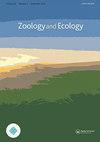Effect of a road on avian diversity in the Kalahari woodland
Q4 Environmental Science
引用次数: 0
Abstract
Roads may have negative or positive effects on wildlife. I surveyed birds along a c. 21 km transect alongside a road from Katima Mulilo to Ngoma bridge in the Zambezi Region, north-eastern Namibia, and on a second transect (control) parallel to the first one and 200–400 m away from the road. The habitat is Kalahari Woodland, partly transformed to cultivated fields. The number of bird species was similar on both transects (56 vs. 48 species; x2 = 0.62, p > 0.05), but the number of breeding pairs (overall population density) was much higher away from the road than close to it (409 vs. 283 pairs; x2 = 22.9, p < 0.01). The Shannon’s Diversity Index was very similar, while Pielou’s Evenness Index was identical in both transects compared. Five species (Blue Waxbill, Burchell’s Starling, Cape Turtle Dove, Fork-tailed Drongo and Grey-headed Sparrow) were dominant on both transects, while the African Grey Hornbill was dominant only on the transect away from the road, whereas the Red-billed Hornbill and Grey Go-away-bird were dominant only close to the road. Four species (African Grey Hornbill, Cape Turtle Dove, Meyer’s Parrot and White-browed Scrub Robin) had population densities significantly higher on the transect away from the road than close to it. However, population densities of nine other species did not differ significantly between the two transects. In general, the avian communities along and away from the road were similar, probably because traffic volume was rather low and the land cover on both transects was similar in terms of natural vegetation and degree of transformation.道路对喀拉哈里林地鸟类多样性的影响
道路对野生动物可能有消极或积极的影响。我调查了纳米比亚东北部赞比西地区从Katima Mulilo到Ngoma大桥的公路沿线约21公里的样带上的鸟类,以及与第一个样带平行、距离公路200-400米的第二个样带(对照)。它们的栖息地是喀拉哈里林地,部分被改造成耕地。两样地上鸟类种类数相似(56种比48种);X2 = 0.62, p > 0.05),但离公路远的繁殖对数(总种群密度)远高于靠近公路的(409对比283对;X2 = 22.9, p < 0.01)。Shannon的多样性指数非常相似,而Pielou的均匀度指数在两个样本中是相同的。五个物种(蓝蜡喙、波切尔椋鸟、角斑鸠、叉尾蜻蜓和灰头麻雀)在两个样带上都占优势,而非洲灰犀鸟只在远离公路的样带上占优势,而红嘴犀鸟和灰远鸟只在靠近公路的样带上占优势。四种鸟类(非洲灰犀鸟、角斑鸠、梅氏鹦鹉和白眉矮丛知更鸟)在远离公路的样带上的种群密度明显高于靠近公路的种群密度。而其他9种的种群密度在两个样带间差异不显著。总体而言,沿路和远离道路的鸟类群落相似,这可能是由于交通流量较低,两个样带上的土地覆盖在自然植被和改造程度上相似。
本文章由计算机程序翻译,如有差异,请以英文原文为准。
求助全文
约1分钟内获得全文
求助全文
来源期刊

Zoology and Ecology
Agricultural and Biological Sciences-Animal Science and Zoology
CiteScore
1.00
自引率
0.00%
发文量
1
 求助内容:
求助内容: 应助结果提醒方式:
应助结果提醒方式:


